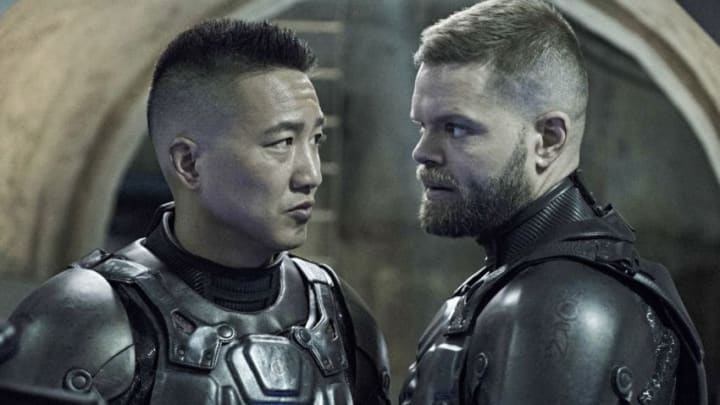In sci-fi TV and movies, hairstyles help shape the universe. In The Expanse, those high-and-tights and top-knots are meant to be familiar.
The universe is perpetually teetering on the brink of war. The very future of humanity appears to be in jeopardy as the mysterious protomocule spreads, adapts and reforms. And through it all, Captain James Holden preserves that squinty poker face, holding off the fates with lidded intensity, the 10-day stubble of an extended space voyage and his antiseptic brushed back locks.
Throughout the three seasons of The Expanse, Holden (portrayed by Steven Strait) doesn’t do much to challenge our previous conceptions of a heroic male protagonist, at least not stylistically. His look could work in just about any story — as a live-action Disney Prince, a World War II marine, a modern tech executive struggling with the intricacies of modern romance, or even a young deputy chasing outlaws across the Oklahoma prairie.
For all its visual flash and intricate world-building, The Expanse chose to play it relatively vanilla when it comes to hairstyles. Young men are buzzed or sporting high-and-tights. The middle-age stiffs in positions of governmental power wouldn’t look out of place on stage at a 2020 Presidential Debate and the women, top to bottom, generally sport unremarkable braids or buns. Even Naomi Nagata’s asymmetrical undercut would quietly blend into the background of a Panera in any corner of suburbia. There are a few exceptions — Thomas Jane’s floppy mohawk — but even that was kept mostly hidden under a ridiculous turn-of-the-century fedora.
To be clear, The Expanse is a wonderful and complex show. The creators, production and design staff invested an incredible amount of time and effort into building a fully realized alternative universe, with parallel cultures, languages and traditions. However, making most everyone in this universe look like us would seem to be a conscious choice as well.
Every human life can be divided into two epochs — before and after seeing Chris Tucker’s hair in The Fifth Element. It’s an eight-inch, apparently hollow, cylinder of blonde curls protruding directly from the center of his forehead. It’s like a late-cubist Picasso painting of Shirley Temple, or if you shave Ian Ziering’s head and pasted those sacred ringlets onto a unicorn’s horn.
The eccentric hair is a perfect physical representation of Tucker’s flamboyantly eccentric character in the film and, as absurd as it is in a vacuum, blends perfectly into the highly stylized universe that director Luc Besson created. Depending on how you feel about Milla Jovovich’s orange dreadlocks or the transparent plastic plate that Gary Oldman uses to maintain his side part, it may not even be the most absurd hairstyle in that movie.
The Fifth Element plays much more heavily on fantasy aspects of the science fiction genre, the universe is not supposed to represent a theoretically plausible point on some future timeline, as is the case with The Expanse. Both stories incorporate action on planet Earth but the fun in The Fifth Element comes from purposefully ignoring plausibility.
Whether or not it is supposed to exist in a hypothetical future of the universe we inhabit, every science fiction television show and movie could be placed on a spectrum of implied plausibility. Production designers are balancing a million elements in arranging the parameters of these new worlds and a hairstyle is often the simplest way to signal to the audience how much they are supposed to hold onto norms they understand, or to let go of them and get lost in the unfamiliar. It’s why, with a new shirt, Luke Skywalker or Han Solo would have looked equally at home in the club from Saturday Night Fever as they did in the Mos Eisley Cantina. It’s why the central characters from Blade Runner 2049 could have also been cast in a Blade Runner 2019 prequel and why everyone from the Grandmaster’s entourage in Thor: Ragnarok could have fit right into The Capital City in The Hunger Games.
When it returns for season 4 on Amazon Prime later this year, The Expanse will pick up where it left off, wrestling with the same themes — the ramifications of tribalism and of governments who default to military solutions, how science and technology always seem to move faster than reason and morality, and how we all deal with the great unknown. And, if, despite the space travel and extra-terrestrial organisms, it all feels a little too real, take a look at Captain Holden’s hair and remember that it’s supposed to.
The Expanse season 1-3 are available to stream exclusively to subscribers of Amazon Prime Video.
